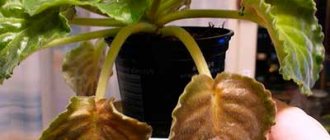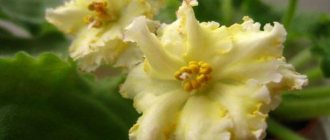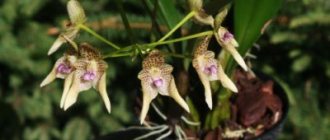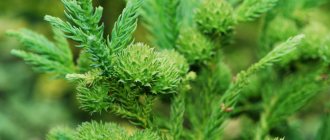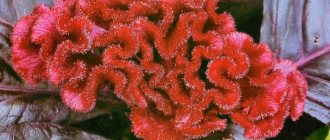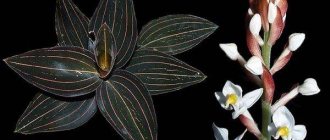Pest protection and disease prevention
Violets are less susceptible to various diseases than other indoor plants.
But if the rules of agricultural technology are violated, various problems arise:
- Spotting. Irregular yellow or brown spots cover the leaves when exposed to direct sunlight or when the leaves are sprayed.
- Chlorosis. It is expressed in yellowing of leaves. Develops with iron deficiency. It is treated by feeding iron sulfate (1 gram per liter of water).
- Gray rot. Fading and wilting of leaves. The only way to save a violet is by trimming and rooting the crown.
- Rust. Brown spots appear on the leaves, then the cuttings become bent. The violet stops growing and does not bloom. The fungus is treated by spraying with copper sulfate or Bordeaux mixture.
- Powdery mildew of violets. The leaves look dusted with flour. The cause of the disease is a combination of cold and high humidity. The disease is treated by spraying with Topaz, Forecast.
Georgia violet may develop chlorosis or rust.
Treatment of diseases is effective only in the early stages. A plant severely affected by the fungus cannot be cured, so it will have to be disposed of so that other plants do not become infected.
Important. If signs of disease appear, it is necessary to carry out an unscheduled violet transplant, regardless of the time of year.
You cannot use an old pot for replanting. The soil and drainage must be replaced. If transplantation is carried out during flowering, all flower stalks must be cut off.
Pests that can enter the apartment from other plants or from flowers cut in a flowerbed cause great harm to violets:
- Aphids are immobile sucking insects that extract juice from leaves and shoots. The surface of the leaves becomes covered with a sticky coating, young shoots become deformed and stop developing.
- Ticks are microscopic insects that are invisible to the naked eye. The leaves of a violet infected with mites begin to become deformed and become covered with white cobwebs and a grayish coating.
- Mealybugs - colonies of pests look like white fluff in the axils of the leaves.
- Sciarides are small mosquitoes whose larvae compact the soil and reduce air access to the roots.
For Georgia violets, not only diseases, but also pests are dangerous.
Names of flowers for creating a balcony flower garden photo
When the first signs of pest infestation are detected, the violet must be isolated from other plants and all damaged parts must be cut off. Then the rosettes with intact leaves need to be transplanted into a new pot with a complete replacement of the soil and drainage layer.
After transplantation, the plant must be sprayed with an insecticide (Alatar, Aktara, Aktellik). To completely destroy the pests, the treatment is repeated three times with a break of 7-10 days.
Location, lighting and humidity
All flowers require good conditions for their cultivation. Violets of any variety need a well-lit place. However, we should not forget that flowers, including the “Margaret” variety, can die from direct sunlight and the burns they leave on the leaves.
If you have a lot of violets, it is better to equip them with special racks with artificial lighting. Flowers of this species need 12 hours of full light to produce the hormones it needs.
The best place to place them is windows that face east and west. South-facing windows should be shaded with parchment paper or mosquito netting to create diffused light.
In winter, it is better to remove violets away from heating systems and additionally humidify the air, as it becomes dry, which can destroy these plants. 60–70% humidity is recommended for them.
Margaret's violet should not be placed on southern windows - direct sunlight will leave severe burns on the plant.
Temperature
Drafts are contraindicated for the plant; if they are overcooled, their leaves will curl; if they are overheated, on the contrary, rotting may begin. The most suitable temperature for this species is 17-20⁰ C.
At an acceptable cool temperature and good humidity, the characteristics of the “Margaret” variety appear - the color becomes rich and bright, the rosettes develop densely.
Organization of watering
Many people make the mistake of believing that violets prefer constant moisture. In fact, they can be watered only after the top layer of soil has dried, that is, as needed. You should not spray them - water on the leaves under the influence of the sun causes burns on these plants.
The pot should not be allowed to dry out or become flooded; this can cause a number of diseases in the plants. You need to water with lukewarm melted or settled water and preferably through a tray. A description and photo of the process will help you avoid a number of problems associated with watering.
Feeding violets Margaret
Margaret violet, like other flowers of this species, require year-round feeding. You should not use universal fertilizers; be sure to use fertilizers only for flowering plants. In winter there is enough organic matter; minerals are needed more in the autumn-spring periods. During the formation of inflorescences, phosphorus is needed, thanks to it the flowers become larger and more colorful.
Features of feeding:
Violets need fertilizers that were developed taking into account their characteristics, but you still need to observe the measure: plants will not bloom with excess nitrogen, stepsons and leaves will form intensively, excess potassium can cause yellowing and stunting of growth.
It is better to make the feeding concentration 2 times less than what is written on the package (it is better not to feed the violet more than to overfeed it). It is important to choose a complex fertilizer that corresponds to the stage of plant development, and change them from time to time. For the development of rosettes and leaves, young specimens need more nitrogen. For rich flowering and bud formation, add phosphorus. Potassium will prolong the flowering period. Do not allow solutions to get on the leaves. Feed only after watering and only healthy plants. Do not fertilize in bright sun and after transplantation.
We invite you to read the full description of the violet variety Cherry Blizzard.
Violet Georgia: description of the variety with photographs in the full article.
Georgia Dadoyan violet photo
Uzambara violet.
Family Gesneriaceae - Gesneriaceae.
Genus Saintpaulia hybrida - Hybrid Saintpaulia.
African violet saintpaulia hybrid.
Violets from breeders of the CIS countries - “D”.
Georgia (T. Dadoyan).
Is it possible to keep dried roses and other dried flowers at home? how to bypass the ban
The flowers are very large, double, bright pink with a crimson-coated border, the edges of which are decorated with a thick, ruffled green ruffle.
Varietal rosette with straight leaves. Foliage grows very little, elongated petioles. The leaves age and turn yellow very quickly. The rosette is large, sloppy, problematic, and twists the leaves.
When blooming, the color is pale pink, but after a couple of days it becomes deep pink, then lightens slightly. The width and saturation of the border, as well as the brightness of the main color, varies depending on age and time of year. In cool conditions the flowers develop a nice greenish ruffle.
Different peduncles of the same rosette can produce flowers of different color intensity. The first flower on the peduncle is the largest - up to 6 cm, the rest are slightly smaller.
From one leaf you get both wavy children and those with straight leaves. It grows very slowly. It is necessary to remove the flower stalks several times in a row, then the leaf mass begins to grow. The socket got better after I switched it to the wick. A sport with curly leaves, a very ugly rosette.
Georgia is a state in the southeastern United States. The capital and largest city is Atlanta. Georgia's official nicknames are the “Peach State” and the “Imperial State of the South.”
Before the Spanish colonization of America, there was an Indian culture in Georgia that completely disappeared by 1560.
Do you know that…?
- Elegant spathiphyllum wallis: is it easy to grow at home and are there any difficulties in care?
Pink varieties. This category includes all shades of pink, from delicate to rich, almost raspberry. Pink is one of the most difficult colors.
There are many shades of pink: hot pink, hot carmine pink, dark pink, light pink, bright peach, mauve, soft pink purple, warm, cool, muted, beige pink and taupe pink. -raspberry and pink-coral. Any pink is always a complex mixture of several tones.
Before you buy the violets listed below, carefully read the forums about their behavior on the windowsill. Many of them are very beautiful flowers.
Are they suitable for your window sill and the conditions that you can create for them? You will look at the flowers for several months, and the rosette will always be in front of your eyes.
There are many beautiful flowers, there are much fewer beautiful and neat rosettes, look first at the rosette! Search and you may find a dozen violets with the same flower color if you are not interested in the smallest details as a collector.
• — Wedding Day (Lazarenko); • — Day by Day (Arkhipov); • — Curiosity (Morev); • — Brownie Kuzya (Burkatsky); • - Dulcinea (Prilutskaya);
Violet, thanks to its beauty and variety of varieties, has won the love of many plant growers. It does not require much attention to itself, but will delight you with large and beautiful flowers if you fertilize it on time and give it the necessary amount of light and moisture.
Description of the variety
Violet "Georgia" from breeder T. Dadoyan has pink, large double flowers. Along the edge they are decorated with a yellow-green border and a crimson coating. The border can be thick or thin, depending on the time of year.
The intensity of the color of the flowers also changes. The first flowers are the largest, they reach a diameter of 6 centimeters, the subsequent ones are smaller. There are many flower stalks, and when the buds bloom, they fall under the weight.
In order for the leaf mass to grow, it is necessary to remove flower stalks more often. There is not a lot of foliage on the bush; it is all straight, quickly dies and loses its attractiveness, and therefore requires timely pruning.
The rosette turns out to be sloppy, so the foliage often curls.
Indoor conditions
In general, violets are able to adapt to different indoor conditions, but sometimes they can be capricious and not bloom.
It is best to maintain the inside temperature between 21 and 23 degrees during the day and at night at least 15 degrees. These are plants that prefer high humidity in their environment.
It is especially important to take care of this in winter, when the heating is on in the room and the air becomes completely dry.
Variety of colors and shapes of collectible Saintpaulia flowers
Collectible Saintpaulias are classified according to several criteria:
- According to the size of the rosette of leaves, they come in rosette diameter: micromini - up to 8 cm;
- mini – no more than 12-15 cm;
- semi-mini – up to 20 cm;
- standard – from 20 to 40 cm.
by flower size:
- small-flowered - less than 2 cm;
medium-flowered - 2-4 cm; large-flowered - 4-6 cm; especially large-flowered - more than 6 cm.
depending on the shape of the flowers:
- pansies - consist of 5 petals arranged in 2 rows;
star - petals of the same size, placed evenly around the center; bell - the petals grow together to the base, preventing the flower from opening completely; bowl - the petals grow together at the base, forming a bowl shape; wasp - consists of 5 petals - 2 curl up into a tube, 3 go down.
depending on the size of the flowers:
- simple - consist of 5 petals;
comb - semi-double Saintpaulias, have 5 main petals and 1-3 underdeveloped ones; semi-double - from 5 to 10 petals are placed on 1 peduncle; terry - the number of petals is more than 10, the stamens are not visible; “carnations” - the flowers resemble carnations, double, but larger, with many petals on the peduncle.
Classification according to the degree of terry.
This truly gorgeous flower is distinguished not only by its pleasant aroma, but also by its large double flowers of light crimson color. The flower itself resembles a light dress with ruffles fluttering in the wind.
It is impossible not to mention the peculiar color of the leaves, where the light shade gradually turns into a dark emerald color. Be sure to add the Chic Poppy violet to your collection, and it will become the diamond of your garden.
Growing a flower
Planting English roses is somewhat different from planting other types of plants. To make them feel comfortable, it is recommended to follow certain rules: prepare a high-quality landing site, as well as planting material.
Rose Falstaff - variety description
Any option can be used as planting material: seeds or seedlings. However, a large percentage of seeds may not germinate. It is also worth understanding that the characteristics of the parent plant may not be preserved, and therefore the gardener will receive another bush. With seedlings everything is simpler - they take root better, are more likely to take root, and also do not require any special care.
Note! It is recommended to plant in open ground in the spring, when the ground has warmed up. However, it is worth preparing the soil and the flower itself for planting in advance.
This requires at least 3 months, and therefore it is recommended to take care of this in advance.
Selecting a location
Teasing Georgia rose requires planting in a place where there is a fence or wall nearby. They will help protect the plant from gusty winds, which is especially dangerous in winter, since it can blow away the snow cover that protects the flower from frost.
Important! This variety of rose does not like the sun's rays, and therefore it should be planted in shaded areas where the sun does not reach most of the day, but shines for about 5-6 hours a day
At the same time, you should avoid areas where water may accumulate.
The best place to plant a bush
How to prepare the soil and flower for planting
Before planting, seedlings should be prepared: it is necessary to inspect the roots and remove damaged ones, treat the cut areas with activated charcoal or charcoal to disinfect them. Then you need to place the seedling in a root formation accelerator solution for 12 hours.
Soil preparation should begin in advance:
- Dig a hole about half a meter deep and wide. Do this by transshipment, dividing the top and bottom layers into two parts.
- Mix soil with fertilizers.
- The top layer must be lowered to the bottom of the hole, and the bottom layer must be left for pouring.
This substrate will not only be rich in useful microelements, but also saturated with oxygen, due to which the roots will develop faster.
Step by step landing procedure
First of all, you need to dig a hole with a depth and width of 45-50 cm. You should fill its bottom with a small amount of drainage, which can be small pebbles and coarse sand. You should place the plant on top of the embankment, carefully distributing the roots along the hill, and then sprinkle them with soil, lightly pressing it. After planting, it is necessary to water the plant abundantly.
After planting, abundant watering is required
Basics of proper care and maintenance
Lyubasha's indoor violets are not capricious and finicky plants, but they require strict adherence to the rules of home care and maintenance. Only with proper cultivation can you get healthy and harmoniously developed flowers.
Growing space and lighting
The ideal location for violets would be a north window. If you plan to place it on the sunny side of the room, then it is safest to place the pot with the plant on a table next to the window or on a wall shelf. In this case, the window glass must be curtained with translucent fabric or paper to protect it from direct sunlight.
Violet requires about 10 hours of daylight daily for healthy growth and development. During the flowering period, they need more light, so it is advisable to install additional lighting sources, such as fluorescent lamps, at this time.
Temperature and humidity
Do not allow the room temperature to drop below 18 degrees.
In the summer season, a comfortable temperature is considered to be between 20 and 25 degrees. In winter, the room temperature should not fall below 16 degrees, but it is better if it is between 18-21 degrees.
The room with violets should be regularly ventilated, but without drafts. The plant should be protected from sudden changes in temperature and should not be taken outside even in warm weather.
For timely flowering indoors, you need to maintain the humidity level. The ideal option is 50-60%. In hot weather, it is recommended to place the pot with the plant on a wide tray with damp moss or peat.
Watering
It is best to moisten violets with warm melt water or filtered water. When using running water, it must be allowed to sit for a couple of days in an open container. The plant requires watering if the soil mixture in the pot has become dry to the level of an earthen lump at the root. As a rule, in winter violets are watered once every 3-4 days; in summer, daily irrigation is acceptable.
Watering violets is carried out using a watering can with a thin spout, carefully and without getting on the leaves. It is permissible to pour warm water into the pan: the plant will take the required amount of moisture, and the rest of the water must be drained to prevent rotting of the root system.
It is not advisable to spray plants, but during the flowering period it is allowed to lightly spray water on the foliage without flooding the inflorescences.
Fertilizers and fertilizers
In order for the soil in the flowerpot to be endlessly nutritious, it must be systematically fertilized. During the period of active growth, violets need nitrogen fertilizers: they help in the formation of new leaves.
In order for the Lyubasha violet to bloom actively and luxuriantly, it needs fertilizing.
The main thing is not to overdo it, because a large amount of nitrogen leads to the cessation of flowering. To form buds, potassium-phosphorus fertilizers are applied.
Indoor violets are fertilized 2-3 times a month, but you should not apply fertilizer immediately after transplantation (1-2 months), in extremely low or high temperatures, in dry soil, and if the plant is weakened by diseases and pests.
Typically, violets growing on windowsills are fed from February to November. Flowers grown on shelves under artificial light - throughout the year. It is better to apply fertilizing through a tray to protect the foliage from possible damage.
Feeding schedule and rules
The nutrients contained in the soil last the violet for exactly two months. Then, to ensure normal development and stimulation, the violet must be fed regularly, alternating organic and mineral fertilizers.
The schedule and composition of fertilizers depends on the stage of development and age of the plant:
- For lush and bright flowering, Georgia violet needs fertilizing.
Young rosettes that are actively growing leaf mass are fed once a week with organic fertilizers. You can use hoods such as Biohumus, Humate.
- Young rosettes that have begun to bloom are fed once every 3 weeks with mineral mixtures. The concentration of the solution for young violets is reduced several times.
- During foliage growth, adult rosettes are fed once 2 months after transplantation with nitrogen-containing fertilizer.
- From the beginning of bud formation and until the end of flowering, adult rosettes are fed once every 2 weeks with mineral fertilizers. The main elements needed by the plant during this period are phosphorus and potassium.
Important. After the first wave of flowering, the plant must be given a rest for 30 days, and then fertilizing with mineral mixtures should be resumed.
Fertilizers for fertilizing are diluted in water 3-4 degrees warmer than room temperature and applied to the soil only after watering. To ensure even distribution of nutrients in the soil, it is recommended to feed violets using the immersion method. The pot with the plant is placed in the fertilizer solution for 30 minutes so that the liquid saturates the soil through the drainage hole.
Diseases, pests and ways to combat them
Preventing the development of diseases can be considered spraying with potassium permanganate, as well as a solution of ash. The rose itself is quite resistant to infection, rust and deformation of leaves, but this does not mean that you can calm down and not take measures to prevent the appearance of insects and diseases.
A description of the external characteristics of a rose cannot tell about its beauty. It is great for decorating a garden plot, and therefore is a favorite of many gardeners. It can be cared for by both a novice florist and a master of the craft.
source
Tatyana Pugacheva and her flowers
Kursk breeder Tatyana Pugacheva is known not only in Russia, but throughout the entire post-Soviet space.
A wonderful woman, an excellent florist, made her hobby her life’s work. It is thanks to the efforts and labors of T. Pugacheva that the collections of many flower lovers are replenished with new specimens. Original author's varieties are sold both on the Internet, on a collector's website, and at various flower exhibitions. Tatyana Pugacheva is a well-known collector involved in the selection of new varieties. Her achievements have been recognized at various international exhibitions. She not only brings the fruits of her labor, but also actively communicates with flower lovers, helping them understand how to care for their pets.
Today you can read about Tatyana’s work with flowers not only on her website. The collector's work was noted by flower lovers. New, newly bred varieties are actively discussed on forums for indoor plant lovers.
Breeders were able to develop a large number of species of violets. Read our articles with descriptions of Saintpaulia varieties with the names of the people who grew them:
- Tatiana Dadoyan;
- Natalya Skornyakova;
- Korshunova Elena;
- Natalya Puminova;
- K. Morev;
- Svetlana Repkina;
- Elena Lebetskaya;
- Evgenia Arkhipova.
Plant care
Despite its rather unique appearance and different planting method, caring for the plant should be the same as for other varieties of roses. This means that you can relieve yourself of the responsibility for learning other rules that would need to be followed when caring for a flower.
Watering rules and humidity
It is recommended to water in the evening strictly at the root of the bush. Despite the fact that the plant can survive rain without causing the flowers to wither, it is still not worth risking them again. English rose does not require high soil moisture, and therefore it is necessary to water the soil to 2 cm, no more.
For your information! Depending on the degree of bushiness of the rose, it may need different amounts of water for watering. Curly ones need to be watered with 15 liters of water, and for bushy ones one bucket is enough.
A dry climate can cause the bush to dry out, but excessive air humidity will not improve its condition. If the rose's root system is constantly waterlogged, this may contribute to the appearance of rot. However, increased air humidity can promote the development of fungus or an influx of insects.
Fertilizing and soil quality
The soil for growing should be light, oxygenated, and rich in nutrients. For active growth and abundant flowering, constant fertilization is required. In the first year after disembarkation, such activities may not be carried out. Starting from the second year, it is worth applying the following types of fertilizing at certain periods:
- during the growing season, the plant needs nitrogen to form stems;
- during the formation of buds and subsequent abundant flowering, nitrogen and phosphorus fertilizers are required;
- To increase frost resistance, it is worth starting fertilizing with potassium at the end of autumn.
It is not recommended to risk the plant by applying fertilizing in the wrong order, as this will confuse the rose; it may begin to lay buds during the dormant period, or begin to grow greenery abundantly during the budding period.
Pruning and replanting
Plant formation is especially important for the plant. Pruning should be done before the onset of frost in autumn and early spring.
Preventive removal of dry and broken shoots will allow the bush to send out fresh shoots more intensively. You can trim the stems as desired:
- severe pruning - shortening shoots by half their length;
- middle pruning - removing only side shoots;
- light pruning - removing a fifth of the stem.
Important! To complete the formation of the bush, feeding is required so as not to drive the plant into stress. It is also necessary to remove faded buds
Bush after pruning
Features of wintering a flower
Before wintering, it is recommended to remove all fallen leaves from under the bush, and also treat the plant with drugs that prevent the occurrence of fungal infection. Not every winter there is a large amount of snow, and therefore it is worth building additional shelter. It is made from spruce spruce branches, which are covered with lutrasil on top.
The branches need to be bent to the ground. If they are not flexible enough, you can carefully dig them up on the side opposite the fold. To prevent the branches from starting to rot, you should place spruce branches under them and secure them with staples in this position.
Characteristics of strawberries Jolie
The characteristics of any variety consist of a description of its advantages and disadvantages. The advantages of strawberry Jolie are quite numerous:
- the yield is above average (740–900 g per bush);
- large and one-dimensional berries, a large percentage of fruits of the 1st quality class;
- resistance to leaf diseases and root rot;
- drought resistance;
- independence of the quality and size of berries from air humidity;
- ease of propagation and good survival rate of seedlings;
- good adaptation to the conditions of different regions.
Disadvantages can be found in almost any selection achievement. Jolie is not without them:
- yield can vary greatly depending on the climate and soil conditions of the growing region (can fall up to 500 g from 1 bush);
- When grown on poor soils, increased fertilizing is required, which must be selected individually for each soil type.
Indoor conditions
In general, violets are able to adapt to different indoor conditions, but sometimes they can be capricious and not bloom. It is best to maintain the inside temperature between 21 and 23 degrees during the day and at night at least 15 degrees. These are plants that prefer high humidity in their environment.
It is especially important to take care of this in winter, when the heating is on in the room and the air becomes completely dry.
Professionals use automatic humidifiers; you can take a simple spray bottle or place containers with pebbles and water on the window. An east or west window is best for violets. You can also use the northern part, but only in summer.
Watering
When watering violets, the grower should avoid getting water on the leaves, since moisture becomes the main cause of subsequent fungal infections. The main problem that novice florists do not think about is water temperature. If it is cooler or hotter than the foliage, it can cause damage called "ring spot."
The temperature of the irrigation liquid should be from 18 to 23 degrees. This is the threshold that is considered safe for most indoor plants. To preserve a flower, it is better to water it under a bush or use a wick, a container with small stones and water. The long spout of the watering can allows you to properly moisten the soil without splashing the leaves. One of the main problems that the grower faces is the formation of white spots on the leaves. This happens when cold water enters.
We cannot rule out completely moistening the soil from above, since this is how it is possible to remove excess salt from the soil, which is deposited as a result of fertilizing. It is always necessary to check the soil before adding a new portion of moisture. If it is still wet, it is worth postponing the procedure for a few days, otherwise the grower will face the problem of root rot.
Pest protection and disease prevention
Violets are less susceptible to various diseases than other indoor plants.
But if the rules of agricultural technology are violated, various problems arise:
- Spotting. Irregular yellow or brown spots cover the leaves when exposed to direct sunlight or when the leaves are sprayed.
- Chlorosis. It is expressed in yellowing of leaves. Develops with iron deficiency. It is treated by feeding iron sulfate (1 gram per liter of water).
- Gray rot. Fading and wilting of leaves. The only way to save a violet is by trimming and rooting the crown.
- Rust. Brown spots appear on the leaves, then the cuttings become bent. The violet stops growing and does not bloom. The fungus is treated by spraying with copper sulfate or Bordeaux mixture.
- Powdery mildew of violets. The leaves look dusted with flour. The cause of the disease is a combination of cold and high humidity. The disease is treated by spraying with Topaz, Forecast.
Georgia violet may develop chlorosis or rust.
Treatment of diseases is effective only in the early stages. A plant severely affected by the fungus cannot be cured, so it will have to be disposed of so that other plants do not become infected.
Pests that can enter the apartment from other plants or from flowers cut in a flowerbed cause great harm to violets:
- Aphids are immobile sucking insects that extract juice from leaves and shoots. The surface of the leaves becomes covered with a sticky coating, young shoots become deformed and stop developing.
- Ticks are microscopic insects that are invisible to the naked eye. The leaves of a violet infected with mites begin to become deformed and become covered with white cobwebs and a grayish coating.
- Mealybugs - colonies of pests look like white fluff in the axils of the leaves.
- Sciarides are small mosquitoes whose larvae compact the soil and reduce air access to the roots.
For Georgia violets, not only diseases, but also pests are dangerous.
When the first signs of pest infestation are detected, the violet must be isolated from other plants and all damaged parts must be cut off. Then the rosettes with intact leaves need to be transplanted into a new pot with a complete replacement of the soil and drainage layer.
After transplantation, the plant must be sprayed with an insecticide (Alatar, Aktara, Aktellik). To completely destroy the pests, the treatment is repeated three times with a break of 7-10 days.
Susceptibility to diseases
Viking grapes have average resistance to diseases such as mildew and oidium.
Mildew and oidium are fungal diseases; to prevent them, first of all, preventive measures are needed:
- collecting and burning affected leaves;
- autumn digging of soil between rows;
- ensuring good ventilation of plants - planting plants with sufficient intervals from each other, timely pruning.
Mildew or downy mildew is one of the most dangerous fungal diseases of grapes. The disease is caused by a fungus that overwinters directly on withered leaves and tolerates frost well. The onset of the disease can be seen by oily spots and white coating on the leaves. At the next stage, yellow spots and leaf necrosis appear. The whitish fuzz spreads to the inflorescences and can lead to large yield losses.
Photo gallery: signs of mildew disease
If whitish fluff has already appeared on the leaves or the grapes have already been affected by mildew in the previous season, you cannot do without chemicals. Such drugs as Radomil, Delan, Thanos, Profit show high effectiveness. Young plantings in spring need to be sprayed approximately every 10 days, and from mid-June every week. When processing, use the dosage of the drug specified by the manufacturer.
Oidium, or powdery mildew, is the most common disease of grapes. Unlike mildew, fungal spores overwinter under the scales of the eyes and on the shoots themselves; at temperatures above 18, the spores begin to actively germinate and affect all parts of the plant. At the beginning of summer, infected buds and leaves turn yellow, and a gray powdery coating appears. Subsequently, the leaves become covered with brown spots and gradually die off, the disease spreads to the berries, which also become covered with plaque.
Characteristic powdery coating of grapes with oidium disease
Treatment of the vineyard against this disease must begin before the buds open. During this period, spraying with sulfur is necessary (dissolve 25–40 g of sulfur in 10 liters of water). After flowering, you can use drugs such as Rubigan, Topaz, Skor, Bayleton, Karatan, following the recommendations of the manufacturers of these drugs specified in the instructions.
Description of the variety
Violet "Georgia" from breeder T. Dadoyan has pink, large double flowers. Along the edge they are decorated with a yellow-green border and a crimson coating. The border can be thick or thin, depending on the time of year.
The intensity of the color of the flowers also changes. The first flowers are the largest, they reach a diameter of 6 centimeters, the subsequent ones are smaller. There are many flower stalks, and when the buds bloom, they fall under the weight. In order for the leaf mass to grow, it is necessary to remove flower stalks more often. There is not a lot of foliage on the bush; it is all straight, quickly dies and loses its attractiveness, and therefore requires timely pruning. The rosette turns out to be sloppy, so the foliage often curls.
Reviews from flower growers
Flower growers note that the Georgia violet has very beautiful flowers.
Irina . Flowers of the Georgia variety are simply gorgeous, not violet. For such beauty of flowers, one can forgive the variety even a spreading rosette with twisted foliage. Although the rosette looks sloppy only in young rosettes, as the violet grows older it evens out.
Elena . To grow the rosette, it took about two months to remove the flower stalks. But the leaves still grow very slowly. But the variety is very colorful. To get a green ruffle, you need to keep the plant at a temperature no higher than 21-22 degrees.
Svetlana . My relationship with the variety did not work out from the very beginning. I was jealous of my friend’s gorgeous Georgia flower and took two leaves. At first I waited six months for the children, then the rosette grew and became like a helicopter with five blades. Flowers appeared only after 2 years, and even then they were not as gorgeous as my friend’s. In general, I eliminated Georgia and decided not to suffer anymore.
Reproduction methods
There are 4 methods of cultivating violets, thanks to which you can replenish your plant collections:
Leaf (or cuttings): a healthy leaf is cut at an angle of 45 degrees, no more than 4 cm long, washed with warm water. Root in both light soil and water. Effectiveness increases if you add crushed sphagnum moss and peat tablets with humus. A month later, the babies will appear, they are separated and transplanted. When rooting in soil, make a greenhouse with a glass jar or polyethylene, remove it after a little more than half a month.
Stepchildren: a stepson (daughter rosette) is a small process that appears in the axil of a violet leaf; it is advisable to remove them. Before separating the stepson from the plant, pinch its growth point and wait until 4-5 leaves appear. Then the stepson is carefully cut out and rooted in a pot, covered with film. When several stepsons appear, one is left and the rest are removed.
Children: a child is a small independent sprout with its own root. Children of the Uzambara violet germinate at the rooting site of the cutting in 2.5-3 weeks. There can be several of them at once if there was a strong cutting. Next, you need to wait for 2-3 pairs of leaves, after which the children are separated and planted. They are separated in two ways
One of the methods is best done by hand, carefully remove it from the pot, clean it from the soil, then separate the children from the cuttings and from each other. The second is “closed”, the children are separated as the root grows and is formed by cutting with a sharp knife and transplanted into a container with a substrate for violets
This method is effective because the mother cuttings are not injured, which makes it possible to obtain several more groups of children.
By seeds: seeds can be collected or purchased. To sow Uzambara violet seeds, including the Margaret variety, you need a container no deeper than 5 cm; it is filled with loose substrate into a ball 1-1.5 cm smaller than the depth of the container. Sow violet seeds in moistened soil evenly over the surface and cover with glass or white paper to create a stable temperature. The temperature regime is maintained in the range from 17⁰C at night to 21⁰C during the day. We must not forget about periodic ventilation; in the first days it is carried out very carefully. After 15-20 days, the first shoots will appear; as they grow after picking and growing, using the same greenhouse method, the shoots are planted separately.
Fertilizers
If the violet is grown under artificial light, then it is worth applying fertilizer year-round in a smaller dose than indicated on the package, but once every 2 weeks. It is advisable to use formulations with a high content of phosphorus and nitrogen, since they are essential for flowering. We must not forget about other microelements and vitamins.
The best choice is a ready-made balanced liquid composition with detailed instructions for use.
The most popular varieties
Dadoyan worked with violets for about 5 years and during this time there are no more than 20 varieties of her selection. The most commonly heard varieties are:
- Georgia - violet flowers are large, double, bright pink in color with a crimson border-spray, the edges of the border are decorated with a thick, corrugated green ruffle. Strong peduncles, curly basal rosette. The leaves are regular, slightly pubescent. Georgia contains a lot of buds on the bush, the flowering period is short.
- Maria is a beautiful curly sport from the Fairy variety. It has large, heavily double pink flowers with a raspberry coating and a green ruffle along the pom-pom flower.
- Aquatic - flowers are bright deep blue, double, with streaks or lightened fragments along the edges of the petals of a pinkish tint. Along the edge of the petals there is a green ruffled border. The leaves are dark, quilted with a slightly wavy edge. Sometimes the leaves have red spots on the white backside. The violet grows quickly, the buds blooming very slowly, but simultaneously.
- Snow White - the flowers of the plant are large, in the form of fluffy terry balls of pure white color with wavy edges of the petals. The leaves of the violet are glossy, wavy, bright green. The plant stands out for its abundant bouquet flowering.
- Grinya - flowers are large, fluffy, semi-double and double, white with a thick corrugated green ruffle along the edge of the petals. The leaves are regular, lanceolate, slightly pubescent. It blooms with a magnificent bouquet, abundant flowering.
- Droplet is a plant with large, semi-double, white flowers with wavy edges of the petals. Each flower has a distinct purple eye in the center of the bud. The leaves are elongated, light green in color. The rosette is neat at the root. The plant blooms quickly, blooms profusely and for a long time.
- Wild cherry - the flowers of the plant are large, semi-double, bright cherry color with a clear, wide white border. Externally, the flower can be compared to a multi-pointed three-dimensional star. The leaves are dark green, spoon-shaped, lanceolate. Wild cherry is a sport from the Frosty Cherry variety.
- Running on the waves - the flowers are huge, double, variable white with dark blue fragments interspersed. The leaves are regular, dark green. The rosette is neat at the root. The plant blooms quickly, blooms profusely and for a long time.
- The poet Yuri Gal is a soft pink, “porcelain” violet; it got its name in honor of the poet Gal, whose prisoner Tatyana’s father once saved in Stalin’s camps. Then Dadoyan had one goal - to save, survive and joy will come. This plant is capricious; if not properly cared for, it quickly dies, but its goal is also to survive and give joy.
Forum of flower growers Frau Flora
About growing indoor and garden plants; discussion of species, varieties, diseases, pests.
Georgia (T. Dadoyan)
Moderator: Floriana
Georgia (T. Dadoyan)
Post by Tatyana L. » Dec 20, 2013, 07:42 pm
Saintpaulia Georgia (T. Dadoyan)
Dear violet lovers, I want to apologize to everyone who purchased Georgia and especially to Olga Viktorovna, who, at my suggestion and after my confirmation, calls the variety Georgia with curly leaves. This is, of course, a mistake. I explain this only by the fact that then, namely in February 2012, I had a very, very difficult period in my life related to my health. I took out old notes about how it was and how the variety was created, I won’t write in detail, I’ll just say that this plant with straight leaves, which Lena showed, is a continuation of one of the five selected seedlings obtained from pollination of Saintpaulia Artic Frost with a pollen mixture from Blue Dragon + Arapahoe +Cinnamon Candy February 18 and 19, 2008, and which was named Georgia in 2010.
At the same time as all the children with straight leaves, a curly child sprouted, as I called it to myself “freak”, out of curiosity I brought it to flowering, but did not root leaves from it. I think the Georgia curly-leaved sport will soon be gone, it is both difficult to grow and also has an ugly rosette.
Re: Georgia (T. Dadoyan)
Post by Elena M. » December 20, 2013, 07:43 pm
Tatyana Lvovna, thank you very much for the clarification!
What you say personally will be taken as an “axiom”. And, I hope, now the confusion of varietal characteristics of this variety will be over.
I am very grateful to you that you responded to our request and wrote a comment on the variety personally! Come visit us again, you are always welcome!
Classification
All varieties of double violets can be divided into groups according to several criteria. For example, depending on the degree of terryness, two main groups are distinguished:
- Terry;
- Semi-double.
In the photo you can see a terry violet. Also, there is a division into groups, depending on the appearance of the Saintpaulia inflorescence:
- Pectinate;
- Carnation.
According to color scheme they are distinguished:
- Light terry violets;
- Dark terry varieties.
IMPORTANT! Violets of several colors conditionally form separate groups of double Gesnerievs. The first includes Saintpaulias of red, pink and raspberry varieties
The second is formed by plants with blue, blue and lilac flowering.
Among the light representatives of terry, in particular, the following varieties are distinguished:
- Atlantis;
- Bridal bouquet;
- Lyubasha;
- And also several others.
Dark Saintpaulias are adequately represented by the varieties Chateau Brion and Gift for a Beloved.
Most often, on the windowsills of avid flower growers, you can see Saintpaulias with a simple type of terry. These plants differ from all other types:
- Leaf shape (round soft leaves of dark green color);
- And also the structure of the flower of the plant.
In representatives of the genus with a simple type of terry, the corolla consists of 4-6 petals.
Flowers with the so-called comb degree of doubleness usually have at least 6 petals in the corolla of the flower. More often, the number of petals of such a plant can be at least 8-9 pieces.
One of the most famous scallops is the Gift for a Beloved variety. It is also distinguished from other terry varieties by the shape of its petals. The fact is that in plants with this type of terry, the top of the flower has a wavy shape with a fringe on top of the flower.
Semi-double flowers are recognizable:
- By the shape and color of the leaves (round or oval, velvety, light green);
- And also by the number of petals in a flowering rosette (from 6 to 9).
In turn, terry Saintpaulias have 10 or more petals in a flower rosette.
As for the degree of terryness like carnations, such varieties have an incompletely opened rosette with semi-double petals.
ATTENTION! The shape of the flowers of such violets resembles carnation flowers, hence their name.
Rose Terracotta - what kind of variety is it?
Terracotta is a rose belonging to the Grandiflora group. To create this group of flowers, breeders crossed Floribunda and hybrid tea varieties. The Terracotta variety has other names: Chocolate Prince, Chocolate Prince, SIMchoca, SIMchoka.
The hybrid tea rose Terracotta is famous for its active flowering, which makes it similar to the floribunda species. But many experts classify these flowers as grandiflora. This flower is also classified as a group of shrubs - semi-climbing shrubs. Rose scrub Terracotta has a developed root system and strong shoots.
What does a Terracotta rose look like?
Rose grandiflora Terracotta appeared in 1994. It was bred by French breeders from (Meilland). Now this flower is extremely in demand in landscape design and floristry.
Petals are brick red, orange, coral, amber or brownish in color
Brief description and characteristics
Terracotta combines the qualities of hybrid tea varieties and floribunda. Its description and characteristics highlight the features of each of these two types.
Note! The Terracotta rose variety is distinguished by very large flowers with a diameter of 12–15 cm. The densely double buds consist of 40–65 petals of a juicy brick-red color. Immediately after the bud opens, its edges become covered with a brown border.
The rose bush blooms very luxuriantly and abundantly. It grows in height up to 70–80 cm. The volume of the bush is approximately 650 cm. Powerful, hard stems firmly hold large flowers, collected in racemose inflorescences. The spines are not very long. The leaves are colored rich green, sometimes with lighter shades. This variety is odorless.
This plant is resistant to many diseases, including fungal infections. The variety has excellent immunity to black spot and powdery mildew. It is quite hardy, frost-resistant, but does not tolerate rain well.
For your information! The terracotta rose got its name from the color of its petals - red with a slight light brown, orange, coral or brick tint.
Large inflorescences
Advantages and disadvantages of the variety
Terracotta has many advantages over other varieties, as well as over many other flowers that are used in landscape design.
Advantages:
- large flower heads;
- abundant and lush flowering;
- stable immunity to most plant diseases.
Experienced gardeners find no drawbacks in this variety.
Use in landscape design
Terracotta is used to make luxurious bouquets. These flowers are actively used in landscape design; they are grown in gardens, flower beds, flower beds and lawns. It is suitable for any landscape style in a variety of compositions. Terracotta beauty will look great with roses of other colors, especially contrasting ones: white, yellow or light pink.
Note! Terracotta park rose will perfectly decorate lawns in gardens, parks and nature reserves. It will give green spaces an exquisite royal look
The petals are pressed tightly together
Terry violet: photo and description
Terry violets are a type of Saintpaulia, or, as it is also called, Uzambara violet. A special feature of the species are the flowers, which are soft to the touch and look like velvet.
Such plants, in turn, have their own classification. Among them there are two types:
- Terry;
- Semi-double.
In addition to the soft velvet petals, terry Saintpaulias are easily recognizable among others. They are distinguished from the general mass by the shape and volume of the inflorescences, as well as the shape of the leaf blade.
ATTENTION! The inflorescences of double violets can consist of 10 or more petals, while semi-double ones have from 6 to 9. If the inflorescence consists of less than six petals, then most likely it is a classic violet with smooth petals.
Varieties of violets
Also check out these articles
- Raspberry variety Glen Ampl
- Lada pear variety
- Livestock industries
- How to plant watermelons with seeds
There are many varieties of violets.
Photo of violet “Frosty Cherry”
- By flower size: small-flowered, medium-flowered, large-flowered, especially large-flowered.
- According to flower color: single-color, two-color, multi-color.
- By flower type: simple, double, semi-double.
- By flower shape: star, pansy, bell, wasp, round flowers, spider.
- By bush size: microminiature; miniature, semi-miniature, standard, large.
- Leaf shape: oval, heart-shaped, round, elongated.
- By leaf type: women's, men's.
- Along the edge of the leaf: smooth, rounded, jagged, corrugated, torn, wavy.
Photo of violet "White Queen"
Interesting!
The most common types of violets have small rosettes with a diameter of 20-40 cm. But there are also giant violets up to 60 cm in size and miniature ones, with a rosette width of about 6 cm.
Tips for growing Margaret violets from experienced gardeners
If you need to leave, use the wick type of watering of violets. To do this, it is better to use a cord with a diameter of about 3 mm (natural ones are not suitable due to their tendency to rot and strong absorption of excess moisture). For watering, the cord is pulled through the hole at the bottom of the pot, laid out in rings, and the other end is lowered into water.
The length of the second end should be such that it reaches and lies on the bottom of the container with water. When watering through a wick, the water should be cooled, boiled with the addition of activated carbon.
Here are some more tips from experienced gardeners:
When choosing a place for violets in the summer on western windows, be careful: the afternoon sun is quite aggressive and can harm the plant. If you have chosen artificial lighting, then you should first choose a lamp, and then make a shelf for it - they should be the same length. If the distance from the plant pot to the lamp is more than 40 cm, two 40-watt lamps are needed. At 20-30 cm, one is enough. High-moor peat with sand or perlite (2:1) is the best soil
You need to be extremely careful with perlite: it is very dusty and can harm the bronchi and lungs. If salts appear on the surface of the soil in a pot or mold appears, try carefully loosening the top layer of soil, sprinkle with river sand or put fresh sphagnum moss (1 cm).
If you are away for a long time, you can use wick watering of Margaret's violet.
Are the kids sick?
Are violet babies sick?
Good day, dear forum users!
I decided to contact you again with a problem. I bought baby violets a month ago, but they haven’t grown a centimeter in that time.
I water them very carefully, the lighting is sufficient. After looking at the information on the forum, I thought that someone was preventing my children from developing. But since I have never encountered problems of this kind, and I am a beginner violet grower, I decided to consult with professionals!
Droplets on the leaves - Fitoverm solution. I found black moving dots on the abutilons and decided to immediately etch the children for prevention.
- Problems with children
- I have a question!
Soil and container
On the market today it is not a problem to find a special, ready-made soil for violets, but you can make it yourself. The potting mixture is prepared from equal parts of peat, vermiculite and perlite. When replanting, do not compact the soil too tightly, since violets prefer well-aerated soil and bloom in a larger pot, but ensure that the distance between the root system and the walls is no more than 2 centimeters.
The pH of the soil should be about 6.0-7.5; lime can be added if necessary to reduce the acidity of the soil. It is possible to add an infusion of cow manure, but very diluted, as well as loam or clay. It is allowed to use not only clay containers, but also plastic containers.
Transplantation after purchase and during reproduction
It is necessary to replant the Fairy as the rosette grows. To do this, you can buy the substrate in the store or prepare it yourself.
The soil mixture should consist of:
- 2 parts of turf;
- 1 part peat;
- 2 parts leaf soil;
- 1 part pine litter;
- 1 part vermiculite.
The pot for planting is also important; its diameter should be 2 cm larger than the previous one
It is important that drainage holes are made in the bottom, which will prevent moisture stagnation
Important! When replanting, you need to lay pebbles in a 1 cm layer at the bottom of the pot. Then sprinkle it with a layer of earth.
After this, remove the violet without disturbing the earthen lump. Place it in the center and fill the resulting voids with earth. The plant needs to be deepened to the first leaves. After this, the violet must be watered.
